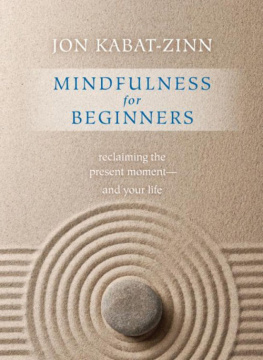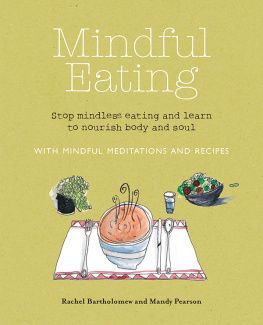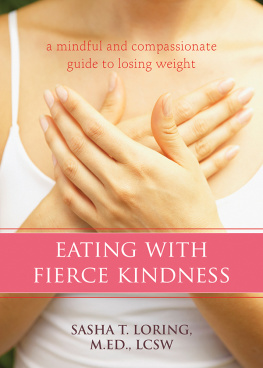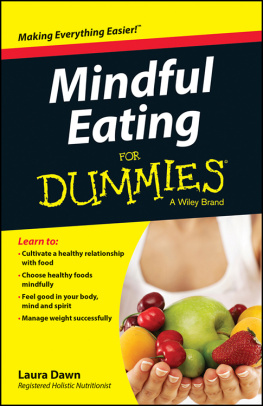Jan Chozen Bays should be recruited by the slow food movement. My favorite mindfulness book from the past year.
Barry Boyce in Shambhala Sun
If you give yourself over wholeheartedly to the practices described here, you will be thanking yourself and Dr. Bays for recovering your life and for enjoying the blessings of food in ways that feel liberated and delightful.
from the foreword by Jon Kabat-Zinn
ABOUT THE BOOK
The art of mindfulness can transform our struggles with foodand renew our sense of pleasure, appreciation, and satisfaction with eating. Drawing on recent research and integrating her experiences as a physician and meditation teacher, Dr. Jan Bays offers a wonderfully clear presentation of what mindfulness is and how it can help with food issues.
Mindful eating is an approach that involves bringing ones full attention to the process of eatingto all the tastes, smells, thoughts, and feelings that arise during a meal. Whether you are overweight, suffer from an eating disorder, or just want to get more out of life, this book offers a simple tool that can make a remarkable difference.
In this book, youll learn how to:
- Tune into your bodys own wisdom about what, when, and how much to eat
- Eat less while feeling fully satisfied
- Identify your habits and patterns with food
- Develop a more compassionate attitude toward your struggles with eating
- Discover what youre really hungry for
Mindful Eating also includes a 75-minute audio program containing guided exercises led by the author.
JAN CHOZEN BAYS, MD, is a Zen master in the White Plum lineage of the late master Taizan Maezumi Roshi. She serves as a priest and teacher at the Jizo MountainGreat Vow Zen Monastery in Clatskanie, Oregon. She is also a pediatrician who specializes in the evaluation of children for abuse and neglect.
Sign up to learn more about our books and receive special offers from Shambhala Publications.

Or visit us online to sign up at shambhala.com/eshambhala.

Shambhala Publications, Inc.
Horticultural Hall
300 Massachusetts Avenue
Boston, Massachusetts 02115
www.shambhala.com.
2009 by Jan Chozen Bays
All rights reserved. No part of this book may be reproduced in any form or by any means, electronic or mechanical, including photocopying, recording, or by any information storage and retrieval system, without permission in writing from the publisher.
Library of Congress Cataloging-in-Publication Data
Bays, Jan Chozen.
Mindful eating: a guide to rediscovering a healthy and joyful relationship with food / Jan Chozen Bays; foreword by Jon Kabat-Zinn.1st ed.
p. cm.
Includes bibliographical references and index.
eISBN 978-0-8348-2261-0
ISBN 978-1-59030-531-7 (pbk.: alk. paper)
1. Food habitsPsychological aspects. 2. Compulsive eating. 3. Thoughtfulness.
4. ConsciousnessReligious aspectsBuddhism. I. Title.
TX357.B455 2009
394.1dc22
2008032480
Dedication
TO MY PARENTS , Bob and Jean Burgess, who taught me love for every kind of food and passed on their instinctive understanding of mindful eating. May Dad find a huge table with discounted, bruised produce and day-old bread in heaven and may Mom be able to persuade him that angels only eat the most expensive and largest avocados.
To my husband, who is naturally free of desire for all food except coffee and cheese. His lack of emotion about food has been a wonderful antidote to my passion for it.
Contents
To see a World in a Grain of Sand
And a Heaven in a Wild Flower,
Hold Infinity in the palm of your hand
And Eternity in an hour.
William Blake
IT IS HARD TO THINK OF a biological function more essential to sustaining our life than eating, since, unlike plants, we dont photosynthesize sustenance out of light and air. Breathing happens on its own, thank goodness. Sleeping too. But eating requires some deliberate engagement on our parts in either growing, gathering, hunting, shopping, going to a restaurant, or otherwise acquiring a range of life-sustaining foodstuffs that often need some kind of preparing and combining by us or others to be maximally beneficial. As mammals, we have complex circuitry in the nervous system to insure that we are motivated to find and eat food (hunger and thirst) and to know when those urges have been satisfied and the body has gotten what it needs for the moment to sustain itself for a time (satiety). Yet, it is all too easy for us in this postindustrial era to take eating so for granted that we engage in it with huge unawareness, and also freight it (all puns intended) with complicated psychological and emotional issues that obscure and sometimes seriously distort a simple, basic, and miraculous aspect of our lives. Even the question of what food really is takes on whole new meanings in an age of industrial agriculture, factory processing, and continual invention of new snacks and foods that our grandparents wouldnt recognize. And with a huge and sometimes obsessive preoccupation with health and eating in this brave new world, it is equally easy to fall into a certain kind of nutritionism,and celebrating the miracle of sustenance and the web of life within which we are embedded and upon which we depend.
On a parallel note, mind-states of unawareness, addiction, and delusion sadly abound in this world and, we might say, function as equal opportunity destroyers of sanity, well-being, and authentic relationship at every level of the body, mind, and world. Every single one of us suffers from them to one degree or another, not simply around food and eating, but in many different aspects of our lives. It is part and parcel of the human condition, perhaps made worse in this era by the particular stresses and pressures of our nonstop, 24/7 connectivity, attention-deficit hyperactivity, celebrity-obsessed culture. But the good news is that the inner and outer pressures on our minds and bodies and the suffering that comes from these sometimes unhealthy influences can be recognized and intentionally worked with to the benefit of anyone willing to undertake the cultivation of even a bit of mindfulness and heartfulness. This book is a gentle invitation to engage in that healing, and a wise guide to accompany you on the journey of a lifetime into your own wholeness.
Nowhere are the elements of the human condition we call unawareness, addiction, and delusion more poignantly and tragically manifested nowadays than in widespread disregulations and disorders in our relationships to food and to eating. These pathologies of imbalance are driven by many complex factors in society itself. Sadly, they have resulted in cultural norms that support particular brands of delusion, obsession, and endless preoccupation with how much the body weighs. It manifests as a gnawing and pervasive, if sometimes submerged and disguised or overcompensated-for discomfort and dissatisfaction with how ones body looks and how it feels inwardly. This pervasive dissatisfaction nests itself within ordinary concerns about ones appearance, but is compounded by desires to fit in to an idealized model of how one should look and the impression ones appearance should make on others that shape and trump the authenticity of ones own interior experience. This dissatisfaction in the mind lends itself to pathologies associated with body image, distortions in how one perceives oneself inwardly and outwardly, and with deep issues of self-worth. Catalyzed in large measure by ubiquitous media exposure, it is prevalent even in children and adolescents, and is pervasive across the life span and right into old age. The sadness of it all is immense and needs to be met with boundless compassion and self-compassion, as well as effective strategies for restoring balance and sanity in our world and in our individual lives.
Next page














